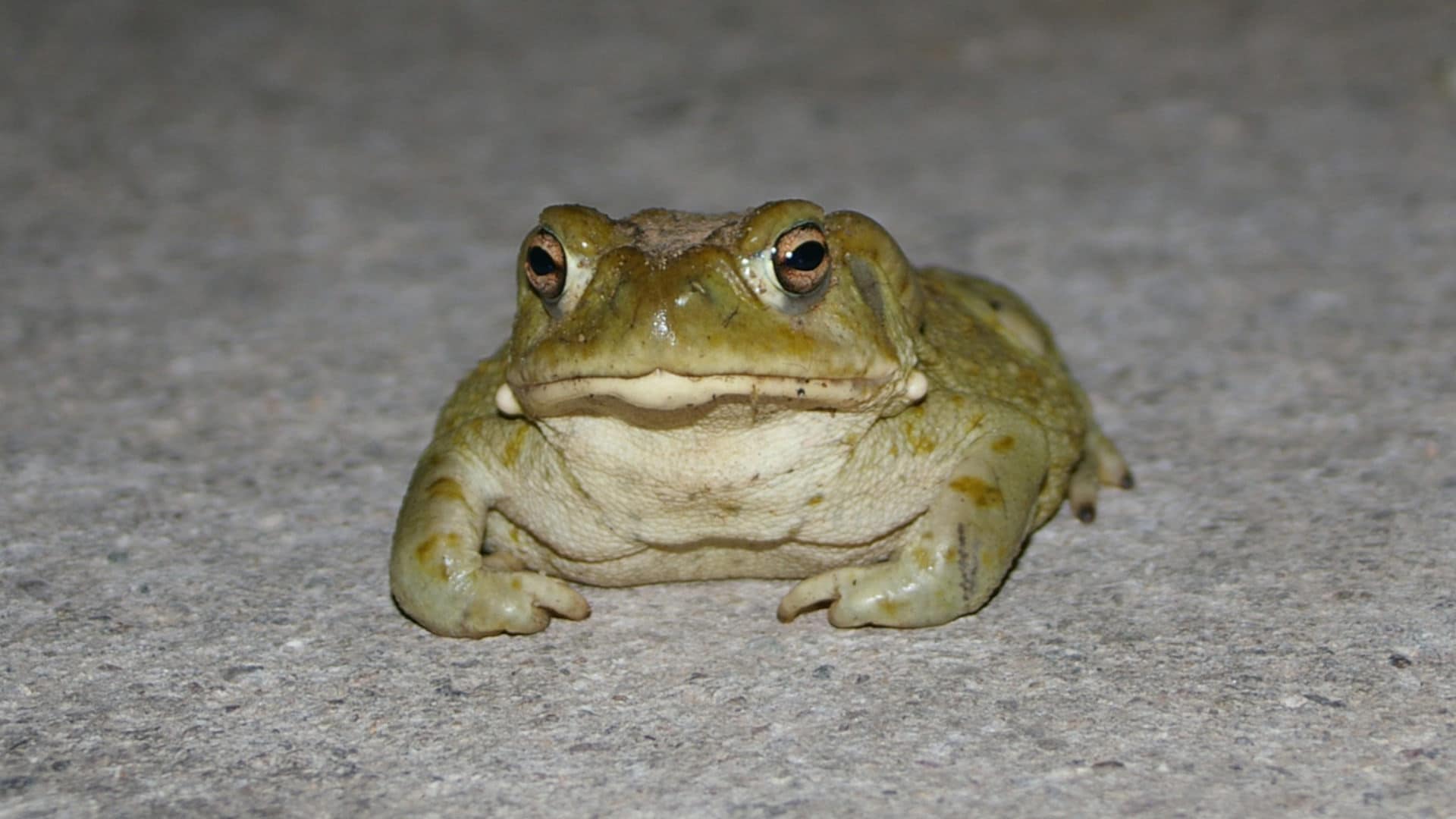A Threatened Toad’s Hallucinogenic Secretions Are in High Demand
Late on a Thursday evening in July 2018, three intruders were caught on a wildlife camera at the Spur Cross Ranch Conservation Area, a park north of Phoenix. Holding flashlights, they scoured a Mexican lily-filled pond near a popular hiking trail, on the hunt for Sonoran Desert toads. One girl squealed as she held up a fat one — both hands wrapped around its belly — and dropped it into a plastic bag. Later, a young man wearing a tattered cowboy hat and a tank top came into view, his face and hand looming large in the camera frame as he clenched a grocery bag. A jumble of legs pressed frantically into the thin plastic, captive amphibians trying to escape their new prison.
“That is like the last thing I expected to see,” Kevin Smith, Spur Cross Ranch’s sole park ranger, said. He estimates, from the footage, that the thieves grabbed at least a dozen toads. Though the recordings — and the story’s peculiar nature —made local and national news, briefly causing a stir, the culprits were never caught. What happened to the creatures isn’t hard to guess, however: In recent years, psychedelic enthusiasts have been rounding up Sonoran Desert toads in order to obtain their secretions, which contain a powerful hallucinogenic substance called 5-MeO-DMT.
In “toad medicine circles” — underground ceremonies that take place across the country in swanky areas from Malibu and Santa Fe to what one participant described as “on the floor of a chic apartment on the Upper West Side” of New York City — the psychedelic has become the latest trendy shortcut to spiritual awakening. Ceremony participants often lie down on the ground, on blankets and sarongs, and smoke the dried secretions — a Schedule 1 drug — , which induce an otherworldly state that lasts for about half an hour. Many who’ve undergone the experience refer to the poison as a “god molecule” that has cured their addictions or helped them achieve a deeper connection to the Earth. Toad altars, T-shirts, and tattoos all profess a worship of the species.
The practice has gone from an obscure desert phenomenon in the ‘80s, to an increasingly popular psychedelic in recent years. In his new memoir, Hunter Biden, President Joe Biden’s son, claimed that 5-meO-DMT helped temporarily cure his addiction to crack. “The experience unlocked feelings and hurts I’d buried deep for too long,” he wrote. “It served as a salve. I stayed sober for a year afterward.” Since 2018, the World Bufo Alvarius Congress in Mexico has attracted hundreds of participants annually from across the globe. (Bufo alvarius, as the toad was formerly named, has since been renamed Incilius alvarius, and is also sometimes called the Colorado River toad.) Many ceremonies take place in the country, and increasingly for white tourists in popular destinations like Tulum on the Yucatán Peninsula, where retreat costs can range from $200 a session to all-inclusive packages upwards of $3,000.
The toad’s newfound popularity concerns Robert Villa, president of the Tucson Herpetological Society and a research associate with the University of Arizona’s Desert Laboratory on Tumamoc Hill. “There’s a psychedelic renaissance that’s happening,” he said, “and there’s a whole sect of this community that is devoted to the Sonoran Desert toad, extracting (it) for psychedelic use.” Villa became aware of the toad’s growing popularity after working in 2017 as a consultant for an episode of a Vice docuseries, “Hamilton’s Pharmacopeia,” in which Mexican practitioners are on camera noting the decline in local toad populations in the state of Sonora. While those who collect the bufotoxin on both sides of the border claim to do so in a sustainable fashion, often releasing the toads afterward, Villa said there’s no real way to do this. “Toads offer those secretions in a defensive context, in a stressed and violent context,” he said. “Ultimately, people are self-medicating at the expense of another creature.” As the toad’s secretions become increasingly popular, Villa is raising the alarm about the practice’s cascading cultural and environmental impacts.
The Sonoran Desert Toad, as its common name suggests, is primarily found in the Sonoran Desert, which stretches from Arizona to Mexico, its habitat also extends slightly into New Mexico and California. The landscape is home to a diverse array of species that have evolved to flourish in the harsh environment. For most of the year, the toad hibernates in underground burrows. In the summer, when the monsoon season hits, it resurfaces to breed in shallow ponds and streams.
It’s during this window of time that it is vulnerable to being snatched from its habitat. But determining the scope of the poaching is difficult. The species is listed as threatened in New Mexico — a 2006 U.S. Fish and Wildlife Service report cites myriad reasons for this, including overcollection — while in California it is believed to be extinct. But in Arizona, where its range is significantly larger, it is still considered abundant; with a valid Arizona Game and Fish license, one can legally collect up to 10 toads per year. “We think poaching takes place. And there have been some anecdotal reports of it (happening),” said Thomas R. Jones, Amphibians and Reptiles Program manager with the Arizona Game and Fish Department. “But even our law enforcement guys don’t have a good feel for toad poaching,” he added, though “that could be because it’s not on their radar.”
Evidence of the growing demand, however, can be found at the U.S.-Mexico border, where Jeff Moore, a senior wildlife inspector with the U.S. Fish and Wildlife Service, said that people have been caught attempting to bring the toad or its secretions into the United States. “We have encountered it and are working with other partner agencies on the enforcement,” Moore said, adding that because of ongoing investigations, he could not comment further on the scope of the trafficking.
Whenever demand for a trafficked species grows, however, there are going to be consequences. When the psychedelic peyote, which is native to West Texas and Mexico, became popular with people outside the Indigenous communities where its ceremonial religious use originated, this led to a black market and a steep decline in the cactus. Steven Benally, a Diné founding member of the Indigenous Peyote Conservation Initiative, told the Los Angeles Times last year, “To these outsiders, we say, ‘Leave peyote alone. Please.’” Beyond the ecological impacts, this type of trade often has cultural implications. As Taylar Dawn Stagner (Shoshone, Arapaho) wrote in High Country News, describing the current “new age” obsession with white sage: “It’s become so popular that it has been commodified to the point of erasure, robbed of its Indigenous roots and cultural importance.”
Oddly enough, the toad’s secretions have no documented historical use in tribes either in Mexico or the U.S. Yet practitioners are still marketing it as a traditional pan-Indigenous remedy, lumping it together with other substances, including peyote and ayahuasca.
The toad itself is culturally significant to the Yaqui Tribe in the Mexican state of Sonora and the Pascua Yaqui in Arizona, playing a symbolic role in tribal stories and ceremonies. But during the last decade, the tribe has noticed a decline in local populations, according to Villa, who consulted with tribal members in Mexico in 2014.
The toad has not been classified as endangered or threatened at the federal level in either Mexico or in the U.S., and it would require extensive monitoring efforts before such a designation could be achieved. Jones said it’s not always easy to determine when to start monitoring a species. “What is often the case is that people like me will say, ‘Yeah, they’re abundant. I see them all the time, like I used to.’ And then, after about 10 years, someone says, ‘Hey, you know, I haven’t been seeing them like I used to.’ And then you start monitoring them in some place and discover that either they’re still there or that they’ve declined.” Jones said. “But because there’s no standard monitoring effort that’s going on for a species like that, it’s really hard to gauge.”
Given that species like the Sonoran Desert toad already face multiple threats, including climate change and rapid urbanization, overcollection can have consequential impacts. “It really kind of shocks me, actually. The fact that people assume, based on its abundance, that it’s fine,” said Villa, who has spent the last few years raising awareness about the toad and its plight. “When you begin to notice something’s happening in those populations, it’s too late.”
UPDATE: This story was corrected to reflect the fact that the Sonoran Desert Toad is not endemic to the Sonoran Desert. Though it is primarily found there, its habitat extends elsewhere.
Jessica Kutz is an assistant editor for High Country News.
This story was originally published at High Country News.











